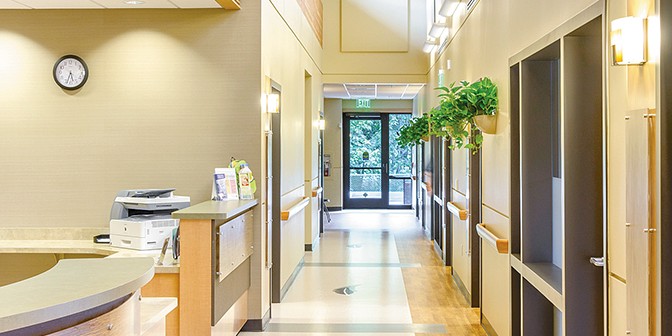(Photo above: Cow Creek Health and Wellness Center in Canyonville, Oregon uses views to the gardens outside and greenery on the inside to promote health and wellness | courtesy of Pinnacle Architecture, Inc.)
Designing healing environments is a mix between art and science. These three research-based design choices can make a big impact on worker happiness, patient healing, and lowering costs.
A room with a “green” view – are they healthier than bricks?
The idea that views of the natural environment can aid healing has been studied for years. A much cited study published in 1984 in the journal Science by environmental psychologist Roger Ulrich was the first to use strict medical research to demonstrate that viewing nature can speed healing. Twenty-three surgical patients assigned to rooms with windows looking out on a natural scene had shorter postoperative hospital stays, gave fewer negative evaluative comments, and took fewer analgesics (painkillers) than 23 matched patients in similar rooms with windows facing a brick wall. Thirty years later multiple studies have continued to show the healing power of viewing greenery to reduce stress and emotional fatigue. Integrating natural window views into healthcare environments is a positive way to promote healing and reduce costs.
Centralized vs. decentralized – which promotes a better work environment?
Centralized nursing stations promote collaboration but they take the nurses away from their patients. In decentralized nursing stations – nurses stationed within rooms – care and attention to the patient increases but collaboration among staff is decreased. According to a study of registered nurses by Peter D. Hart, one of the top analysts of public opinion in the U.S., 700 registered nurses revealed the primary reason nurses leave healthcare, other than retirement, is to find a job that is less stressful and physically demanding. By using a mix of both centralized and decentralized stations the physical layout can provide better care to the patients while allowing staff to collaborate and create a less stressful, collegial environment.
Patient and worker safety – can carpet reduce falls?
Between 700,000 and 1,000,000 patients suffer a fall in U.S. hospitals each year according to the Agency for Healthcare Research and Quality. Multiple studies have found the risk of a fracture resulting from a fall on carpet was significantly lower compared to other floor types. While carpeting might not be the best fit for all environments, the development of carpet tiles (easy to replace sections if damaged), anti-microbial properties, and cushioned backings provide a more viable option in healthcare environments to reduce patient falls and injury.
Healthcare and senior living facilities can benefit from evidence-based design (EBD) options. Whether its research on new and improved interior materials or the configuration of space and green views, organizations like The Center for Health Design and trained EBD experts can uncover simple ways to improve patient outcomes, increase staff satisfaction, and reduce costs.
541-388-9897
www.PinnacleArchitecture.com





